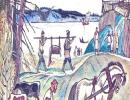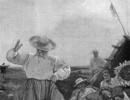: the animals speak for the fabulist. Monument to I.A. Krylov: animals speak for the fabulist Where is the monument to krylov
In 1848, about 30 thousand rubles were collected, which at that time was a very large amount. A competition was announced at the Academy of Arts, dozens of sculptors took part in it to create a monument to Krylov in St. Petersburg (photo below).

Among the numerous participants, Baron Klodt won. The sculptor's preliminary sketches were dedicated to the author's fables and songs.
Soon a monument was created and erected, which can be seen today. He depicts the famous fabulist on a high granite pedestal, which depicts the heroes of his famous works.
The monument to Krylov in St. Petersburg is only 3 meters high, but the work on its creation was long and difficult. Klodt has always been for realism, so all the animals on the monument are depicted as they are in real life.
Creating a masterpiece
The monument to Krylov in St. Petersburg was created for 4 years. The workshops contained animals that served as "models" for their depiction on the monument.

There was also a tame wolf and a she-bear with a cub, a crane, a donkey, a fox and many others. When work on the creation of the monument was over, the animals were moved to a special menagerie.
Throughout his life, I. A. Krylov wrote 300 fables. On the pedestal of his monument are excerpts from 36 of his most famous works.
Informative video about the monument to I.A. Krylov
Where is the monument to Krylov?
The place for installation was chosen for a long time. At first they wanted to put him next to the grave of the famous fabulist, then in the library square, where he worked for more than 30 years, the Neva embankment was also considered.
If you do not know where the monument to Krylov is, then go to the Summer Garden. It was at this place that the sculptor insisted. Why exactly here?
Once in the Summer Garden there was a huge number of various amazing monuments and sculptures. Under Peter I, there was a green labyrinth, and next to it a statue of Aesop (the famous fabulist from antiquity), but unfortunately this great art has sunk into oblivion.

Only the name of the Fontanka River remained, received in honor of the large number of fountains located near the labyrinth. But then, in 1977, he amended history by destroying everything.
Therefore, it is not surprising that after more than 50 years, it was decided to erect a monument to Krylov in St. Petersburg in this famous place.
After 20 years, the monument was fenced with a fence to protect it from vandals, and in the 60s a major restoration was carried out.
During World War II, Krylov was covered with boards and logs for protection, but fragments from shells still could not save him and damaged the monument. In 1945, the monument to Krylov in the Summer Garden of St. Petersburg was restored, and you can see it like this to this day.
share
Not far from the entrance to the Summer Garden from the Neva embankment, to the left of the main alley, among dense greenery, there is a playground, in the center of which there is a monument, fenced with a metal grate. A brief inscription on it reads: “To Krylov. 1855".


performer Alexey Chizhik
Legends and myths
As you know, the sculptor Klodt was a very responsible person.
Having set out to decorate the monument to Krylov with characters from fables, Klodt carefully read all the works of the fabulist and compiled a list of animals, the images of which must be present in the sculptural composition of the monument.
Klodt preferred to sculpt animals from nature.
They say that while working on the monument to Krylov, a whole menagerie was housed in the sculptor's house: a donkey, a cat, dogs, a wolf, monkeys, a sheep with lambs, a fox, a crane, a frog and many others.
By order of Klodt, a bear with a bear cub was even delivered to him.
The sculptor courageously endured the neighborhood with animals, some of which lived in the yard, and some - right in the workshop.
Only Klodt felt antipathy towards one animal: he did not want to be under the same roof with a goat.
However, according to the sculptor's idea, the goat must have figured in the composition of the monument. Klodt managed to arrange for the goat to be taken to him every day by an old woman who lived nearby.
The main problem was to get him to pose: the animal did not want to go to the workshop, it resisted, sensing the presence of a wolf and a bear. But the hostess so wanted to see her pet, immortalized in bronze, that she still forced the goat to go to the workshop. The efforts of the sculptor paid off: the animals decorating the pedestal of the Krylov monument look very natural and believable.
Monument to Krylov was opened in a solemn atmosphere on May 12, 1855 near the main alley of the Summer Garden in St. Petersburg. It is a bronze statue of a seated fabulist.
In 1845, immediately after the death of Ivan Andreevich Krylov, on the initiative of the newspaper "Sankt-Peterburgskie Vedomosti", a Committee was established to raise funds for the construction of a monument to the Russian fabulist. Over the course of three years, the committee collected more than 13,000 rubles in the form of private donations. In May 1848, the Academy of Arts organized a competition for the best design of the monument, in which A. I. Terebenev, N. S. Pimenov, I. P. Vitali, P. K. Klodt and P. A. Stavasser participated. The project of Pyotr Karlovich Klodt, approved on November 26, 1849, was recognized as the best.
The original sketch was made in the monumental tradition of antiquity: a mighty poet in a Roman toga with bare chest. But on the same sheet there is a version of the monument, reminiscent of the one in the Summer Garden.

In the spring of 1854, Klodt cast the monument and minted the bas-reliefs at the Foundry Workshop of the Academy of Arts. On the bas-reliefs placed on the pedestal of the monument to Krylov, the sculptor depicted scenes from Krylov's fables: "The Fox and the Grape", "The Frog and the Ox", "The Lion on the Fishing", "The Crow and the Fox", "The Elephant in the Voivodeship", "The Rooster and the Pearl Grain”, “Raven”, “Quartet”, “Lion and Leopard”, “Monkey and Glasses”, “Wolf and Crane”, “Squirrel”, “Cuckoo and Rooster”, “Demyanova's Ear”, “Fortune and the Beggar”. The creation of the monument to I. A. Krylov is the last major work of the sculptor P. K. Klodt. The artist A. A. Agin helped the sculptor to work on the monument.
As you know, the sculptor Klodt was a very responsible person. Having set out to decorate the monument to Krylov with characters from fables, Klodt carefully read all the works of the fabulist and compiled a list of animals, the images of which must be present in the sculptural composition of the monument. Klodt preferred to sculpt animals from nature. They say that while working on the monument to Krylov, a whole menagerie was housed in the sculptor's house: a donkey, a cat, dogs, a wolf, monkeys, a sheep with lambs, a fox, a crane, a frog and many others. By order of Klodt, a bear with a bear cub was even delivered to him. The sculptor courageously endured the neighborhood with animals, some of which lived in the yard, and some - right in the workshop. Only Klodt felt antipathy towards one animal: he did not want to be under the same roof with a goat. However, according to the sculptor's idea, the goat must have figured in the composition of the monument. Klodt managed to arrange for the goat to be taken to him every day by an old woman who lived nearby. The main problem was to get him to pose: the animal did not want to go to the workshop, it resisted, sensing the presence of a wolf and a bear. But the hostess so wanted to see her pet, immortalized in bronze, that she still forced the goat to go to the workshop. The efforts of the sculptor paid off: the animals decorating the pedestal of the Krylov monument look very natural and believable.

The master lived with large predators - a wolf (sent by the royal huntsmen) and a bear with a bear cub (they were transferred by the sculptor's brother). Such a neighborhood did not cause any particular trouble to Klodt. The animals got along well with each other. Only the wolf constantly hunted cats, and the bear became addicted to alcohol, which the workers treated him to. To sculpt a lion from life, Klodt went to the menagerie of the German Zama on the Fontanka. The sculptor observed the elephant in the menagerie in Tsarskoye Selo. At the end of the work, Klodt transferred all his pets to the Zama menagerie.
From the memoirs of the son of P. K. Klodt:
These animals lived with us as family members. And something that just was not in the vast workshops of his father! They were filled with a continuous roar, howling, bleating, squeaking ... All this motley society lived side by side, not only in cages, many freely walked around the workshop and rooms, and were friendly with each other, except for the wolf, which could not resist not to hunt for cats.
In the spring of 1852, Klodt presented a large model of the monument to the Academy of Arts for consideration. After its approval in May 1853, a bronze monument to Krylov was cast.
The question of the place of installation of the monument was decided for a long time. It was proposed to install it in front of the Academy of Arts, the Public Library, the building of the University (Krylov was its honorary member), in the necropolis of the masters of arts of the Alexander Nevsky Lavra (here he was buried in 1844). However, Nicholas I rejected all these options. As a result, a monument to I. A. Krylov was decided to be erected in the Summer Garden, where the writer often spent time. This option was proposed by the creator of the monument P. K. Klodt.
V.V. Stasov wrote about him:
Krylov sits in front of us on a pebble, in his annual frock coat and pantaloons, a heavy, good-natured slob, as he really was at the end of his life, without embellishment and without the slightest idealization ...
The monument is surrounded by a fence designed to prevent damage to the bas-reliefs. The fence, made in the eclectic style fashionable for the middle of the 19th century, was installed 20 years after Krylov's death, in 1865. An artistic fence was built here to protect the monument from vandals.
During the siege of Leningrad, the monument was covered with wooden shields made of logs. However, shell fragments still damaged both the monument itself and the fence around it. In 1945, the shields were removed, the monument to Krylov was restored.
1768-1844 - years of life of the fabulist I. A. Krylov.
 Monument to Krylov - St. Petersburg
Monument to Krylov - St. Petersburg
In 1845, immediately after the death of Ivan Andreevich Krylov, on the initiative of the newspaper "Sankt-Peterburgskie Vedomosti", a Committee was established to raise funds for the construction of a monument to the Russian fabulist. Over three years, the committee collected more than 13,000 rubles in the form of private donations. In May 1848, the Academy of Arts organized a competition for the best design of the monument, in which A. I. Terebenev, N. S. Pimenov, I. P. Vitali, P. K. Klodt and P. A. Stavasser participated. The project of Pyotr Karlovich Klodt, approved on November 26, 1849, was recognized as the best.
In the spring of 1854, Klodt cast the monument and minted the bas-reliefs at the Foundry Workshop of the Academy of Arts. On the bas-reliefs placed on the pedestal of the monument to Krylov, the sculptor depicted scenes from Krylov's fables: "The Fox and the Grape", "The Frog and the Ox", "The Lion on the Fishing", "The Crow and the Fox", "The Elephant in the Voivodeship", "The Rooster and the Pearl Grain”, “Raven”, “Quartet”, “Lion and Leopard”, “Monkey and Glasses”, “Wolf and Crane”, “Squirrel”, “Cuckoo and Rooster”, “Demyanova's Ear”, “Fortune and the Beggar”. The creation of the monument to I. A. Krylov is the last major work of the sculptor P. K. Klodt. The artist A. A. Agin helped the sculptor to work on the monument.
In the process of creating the monument to Krylov, a lot of birds and animals lived in the sculptor's workshop: a donkey, a cat, dogs, monkeys, a sheep with lambs, a fox, a crane, a frog. From them he sculpted the characters of fables. The master even lived with such large predators as a wolf (sent by the royal huntsmen) and a bear with a bear cub (they were transferred by the sculptor's brother). streets and hotels. Such a neighborhood did not cause any particular trouble to Klodt. Only one animal Klodt did not dare to settle in the workshop - a goat. Every time he was taken to Pyotr Karlovich by an old woman who lived nearby. The animals got along well with each other. Only the wolf constantly hunted cats, and the bear became addicted to alcohol, which the workers treated him to. To sculpt a lion from life, Klodt went to the menagerie of the German Zama on the Fontanka. The sculptor observed the elephant in the menagerie in Tsarskoye Selo. At the end of the work, Klodt transferred all his pets to the Zama menagerie.
From the memoirs of the son of P. K. Klodt:
These animals lived with us as family members. And something that just was not in the vast workshops of his father! They were filled with a continuous roar, howling, bleating, squeaking ... All this motley society lived side by side, not only in cages, many freely walked around the workshop and rooms, and were friendly with each other, except for the wolf, which could not resist to don't chase cats.
In the spring of 1852, Klodt presented a large model of the monument to the Academy of Arts for consideration. After its approval in May 1853, a bronze monument to Krylov was cast.
The question of the place of installation of the monument was decided for a long time. It was proposed to install it in front of the Academy of Arts, the Public Library, the building of the University (Krylov was its honorary member), in the necropolis of the masters of arts of the Alexander Nevsky Lavra (here he was buried in 1844). However, Nicholas I rejected all these options. As a result, they decided to erect a monument to I. A. Krylov in the Summer Garden, where the writer often spent time. This option was proposed by the creator of the monument P. K. Klodt.
The grand opening of the monument to I. A. Krylov took place on May 12, 1855. V.V. Stasov wrote about him:
Krylov sits in front of us on a pebble, in his annual frock coat and pantaloons, a heavy, good-natured slob, as he really was at the end of his life, without embellishment and without the slightest idealization ...
20 years after the opening of the monument, in 1865, an artistic fence was built here to protect the monument from vandals.
During the siege of Leningrad, the monument was covered with wooden shields made of logs. However, shell fragments still damaged both the monument itself and the fence around it. In 1945, the shields were removed, the monument to Krylov was restored.
With a kind smile, with a friendly look,
He, as if with an senile slowness of speech,
Tells us from his high chairs
About strange customs and the stupidity of animals,
And everyone laughs around him, and he himself is quietly cheerful.
Ivan Alekseevich Maykov
Not far from the entrance to the Summer Garden from the Neva embankment, to the left of the main alley, among dense greenery, there is a playground, in the center of which there is a monument, fenced with a metal grate. A brief inscription on it reads: “To Krylov. 1855".
Ivan Andreevich sits on a rounded stone in a calm, relaxed pose, holding an open book. He leafs through it as if mechanically, but his gaze is fixed on top of the book, and thick eyebrows slightly shifted, lips closed and a fold at the mouth give a concentrated expression to his broad face. Immersed in deep thought, he does not notice anything around. Everything is true and natural, like life itself: an old man went out for a walk, got a little tired, sat down to rest on the first stone that came across and thought ... Or maybe at this moment a new fable is born?
The pedestal is small in comparison with the three-meter statue, and on four sides it is completely covered with bronze figures of various animals - the heroes of Krylov's fables.
On the front side of the pedestal, to the right of the inscription and date, are depicted "the naughty Monkey, Donkey, Goat and clubfoot Mishka" with musical instruments, vividly and figuratively resurrecting Krylov's fable "The Quartet". A little higher, the sharp-faced fox from the fable "The Fox and the Grapes" looks greedily at the elastic bunches of grapes.
It is amusing, walking around the monument and carefully examining the bronze menagerie, to recall fables familiar from childhood. Here are the well-known "Crow and Fox", "Elephant in the Voivodeship", "Cat and Pike", "Donkey and Nightingale", "Pig under the Oak" ...
The figurines of animals help to remember the names of the fables, but they do not tell who is hidden behind their image.
“My animals speak for me,” Krylov once remarked. To this we can add that all the animals in his fables are endowed with character, each has its own destiny. They not only speak and act like human beings, but also castigate human vices and social evils.
Animals on the monument in the Summer Garden are depicted very believably, vividly and expressively, but they cannot be considered as illustrations for Krylov's fables, because "in best fables Krylov, there are neither bears nor foxes, although these animals seem to act in them, - wrote V.G. Belinsky, “but there are people, and moreover, Russian people.” There is no allegory in Klodt's animals, without which a fable is unthinkable. There is no likeness in them to certain human characters or social groups, that is, to which a true fable owes its effect.
Krylov wrote about two hundred fables, of which thirty-six are shown by the sculptor on the pedestal of the monument. Bronze figures of animals, depicted in high relief, completely fill the entire pedestal.
From the history of the creation of the monument
After the death of Ivan Andreevich Krylov, in 1845, an article appeared in the newspaper St. Petersburg Vedomosti about raising funds for the erection of a monument to him.
The townspeople and the leadership of St. Petersburg approved this idea and a special Committee was soon created. Over the three years of his life, he collected a fairly large sum by those standards - 13,000 rubles.
In 1848, the Academy of Arts announced a competition for the design of the best monument to the fabulist, in which sculptors N.S. Pimenov, A.I. Terebenev, I.P. Vitali, P.K. Klodt, P.A. Stavasser. The Council of the Academy approved the project of Pyotr Karlovich Klodt.
The project of the monument to the great Russian fabulist in drawing was approved by the Council of the Academy of Arts on November 26, 1849.
A sketch of the monument and drawings of reliefs on the plots of Krylov's fables were made by Klodt's friend artist A.A. Agin. The sculptor worked on the creation of the monument for more than five years. On the pedestal, Klodt depicted characters from Krylov's most famous fables.
Petr Karlovich Klodt
Klodt had to do a long and laborious work on modeling from life all those animals whose images we see on the pedestal of the monument. For four long years, the extensive workshop of the Foundry House turned into a real menagerie, where various animals sat in cages and on a leash, while others, tame and peaceful, roamed freely in the room and even often went into living rooms (Klodt's apartment was connected to the workshop by a passage).
The royal rangers transferred a tamed wolf to Klodt's "menagerie", the sculptor's brother sent a bear with two cubs from the Novgorod province, the artist A.P. Bogolyubov gave a macaque monkey from the island of Madeira, Klodt himself bought a sheep with a lamb, a donkey, a crane, a fox. There were also other animals and birds.
Subsequently, the son of the sculptor M.P. Klodt recalled: “These animals lived with us as family members. And something that just was not in the vast workshops of his father! They were filled with a continuous roar, howling, bleating, squeaking ... All this motley society lived side by side, not only in cages, many freely walked around the workshop and rooms, and were friendly with each other, except for the wolf, which could not resist to don't chase cats.
Klodt often visited the German Zam on the Moika, who kept a large menagerie, where he made sketches of a lion and other predators. And in order to watch a live elephant, one had to go to Tsarskoye Selo. When all the necessary work was completed, Klodt transferred his animals to the Zama menagerie.
In the spring of 1852, the sculptor presented a large model to the Council of the Academy of Arts, and after its approval, he began molding. In May of the following year, he himself cast the monument in bronze at the academic foundry, which he had directed for many years. The statue of the fabulist was cast as a whole, and not in parts, which testifies to the skill of Klodt as a bronze caster.
The question arose about the choice of the site for the installation of the monument: some believed that the best place there will be a section of the Neva embankment between the Academy of Sciences and the university. Others pointed to the square near the Public Library, where the fabulist worked for about thirty years. Still others proposed to erect a monument on the grave of Krylov in the Alexander Nevsky Lavra. Klodt chose the Summer Garden. The sculptor understood that the monument to Krylov would always be surrounded by children, and the Summer Garden was especially loved by them.
There was another reason for the installation of a monument in this garden - tradition.
In the distant past, many outlandish structures were arranged in the Summer Garden for the amusement and pleasure of those walking around. Back in the time of Peter the Great, in a garden on a vast rectangular lawn designed by architect M.G. Zemnov was broken green labyrinth. At the entrance to the labyrinth stood a statue of the great ancient fabulist Aesop, cast in lead and gilded. The most diverse animals - the characters of Aesop's fables, executed in life-size from lead, sparkling with gilding, in living, natural poses, were located in pools decorated with moss, wild stone and large shells. Nearby were signs summary fables and explanations of their parables.
Aesop and his golden menagerie have long disappeared: the fountains were destroyed by the flood of 1777, and their memory is preserved only in the name of the Fontanka River.
After more than half a century, a monument appeared again in the Summer Garden, this time to the great Russian fabulist; on the pedestal of the monument is a bronze menagerie.
The monument to Krylov was opened in May 1855, on the tenth anniversary of the death of the fabulist. More than twenty years after the opening, in order to avoid damage to the bronze bas-reliefs, it was surrounded by a metal fence, made in the eclectic style that came into fashion in the middle of the 19th century.
In 1966 the monument was restored.
Today it is impossible to imagine the Summer Garden without this monument. It is always crowded here. On weekends you can often hear live music. Young xylophone musicians perform favorite melodies of past centuries.






